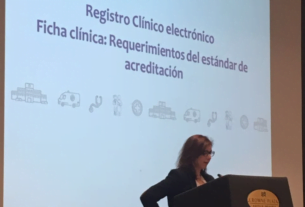Part of the 42nd Argentine IT Events Program (JAIIO), CAIS 2013 took place between the 18th and 20th of September at the Faculty of Mathematics, Astronomy and Physics of the National University of Córdoba.
“This year’s theme means that we are trying to prevent experiences from growing isolated, with companies developing in one way and ourselves another. The idea is to enable us to produce things that help everyone so we’re all going in the same direction,” explained Pedro Escobar, a Biomedical Engineer and Chair of the event, during the opening speech of the congress.
The connection between national and international ministries is a key step toward adapting new technologies that can provide better care. This is why representatives from different governments are sharing their concerns and experiences related to the use of ICTs in healthcare.
The Argentine experience in the use of ICTs in healthcare
The governments present included the ministries from the provinces of Tucumán and Misiones.
The Undersecretary for IT Systems of the Ministry of Public Health of Tucumán, Sergio Epstein, spoke about developments in Tucumán over the past 10 years. One of the main achievements of the province was the construction of a hospital and health center network on which the electronic health record of each patient entered into the healthcare circuit in the province can be shared. As the official explained, 32 public health institutions shared the information of over 1,400,788 patients registered thanks to the health project begun in 2006.
Sergio Daniel Montenegro, the Head of Medical IT Department at Madariaga Hospital shared his experience leading a project implementing the “RISMI” Single Electronic Health Record in Misiones province. RISMI has also been implemented in the Neonatal Maternal Hospital. “We will soon take the Single Electronic Health Record to SAMIC in the towns of Alem and Oberá,” he added.
Representatives of the Joseph Lister Hospital in the town of Seguí in Entre Rios explained how things had improved since they implemented the free hospital management system “GNU Health”.
The National Administration of Medications, Food and Medical Technology (ANMAT) presented its program for paper reduction via the National System of Medical Traceability. Speaking about new projects, the Co-Director of ANMAT, Doctor Rosa Maria Papale, said: “We are developing an online form to prevent secondary problems with medications”. And then, she added: “We received 8000 reports this year, or 500 a month.”
Pedro Kremer, Director of Monitoring and Supervision and a leading proponent of eHealth at the National Ministry of Health, said: “We have information and communication technologies that not only didn’t exist before in the state but that are now being used as a model for other public and private institutions.”
Furthermore, Myrna Marti, regional advisor to the Panamerican Health Organization in communications and eHealth management in Argentina, said: “This is a moment of cultural convergence that leads us to adapt to new technologies.”
Health Information and Communications Technologies in the private sector
As the slogan of the event “Bringing healthcare actors together” would suggest, it is fundamental that the different professionals who work on the implementation of IT in healthcare work together and combine their efforts. In this regard, private services such as SUAT and Swiss Medical shared their experiences with eHealth.
Eduardo Del Piano, Corporate Manager of Systems at Swiss Medical, explained that, on selecting a software provider for the informatization of a care network, the key is to make the investment profitable. For their Vertical Healthcare Project, one of the six candidates was discarded because of the huge budget they required for their service. “We’re talking about millions of dollars of investment, which is a very large investment on the part of the group leading the project,” said Del Piano.
“When selecting a provider who could meet the needs of the project, we had to face up to the reality that we didn’t have an adequate way to evaluate a large project,” explained the Medical Informatician at Swiss Medical, Javier Díaz. The system for choosing a supplier requires very close analysis of each key sector of medical services. “We needed to evaluate their systems point by point; the care process, the electronic health record, and medical prescriptions, among others,” added Díaz.
Selene Indarte, meanwhile, the Medical IT Manager for the Uruguayan firm SUAT, described the mHealth implementation process in the pre-hospital Medical Emergency service. SUAT provided the digitalization solution of tablets with 3G internet and portable printers to paramedics so that they can print out a report for the patient. “We want the doctor in the street to have the same access to information as one in a clinic,” said Indarte.
Cuban progress toward eHealth and the socio-political context
The foreign representatives included the Director of IT and Communications at the Ministry of Public Health of Cuba, Alfredo Rodriguez.
“Healthcare is the area that generates the highest income in the country, we are one of the countries with the highest number of doctors per capita,” said Rodriguez.
Some projects – such as the workers’ Health registry, the Electronic Health Record, the online network of the 47 national blood banks, among others – are a clear example of the Cuban intention to implement Information and Communications Technologies in the Health sector.
However, Rodríguez emphasized the difficulties with making progress in eHealth as the main suppliers of IT solutions are based in the United States.
A meeting point
Once more, the Argentine Health IT Congress has provided an opportunity for academics and professionals in the public and private sectors to share their experiences and to join together in search of better and more efficient patient care.

